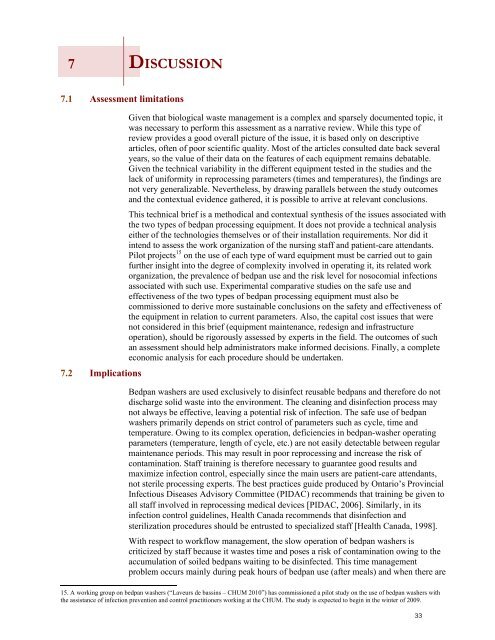Comparative Analysis of Bedpan Processing Equipment - Hygie
Comparative Analysis of Bedpan Processing Equipment - Hygie
Comparative Analysis of Bedpan Processing Equipment - Hygie
You also want an ePaper? Increase the reach of your titles
YUMPU automatically turns print PDFs into web optimized ePapers that Google loves.
7 DISCUSSION<br />
7.1 Assessment limitations<br />
7.2 Implications<br />
Given that biological waste management is a complex and sparsely documented topic, it<br />
was necessary to perform this assessment as a narrative review. While this type <strong>of</strong><br />
review provides a good overall picture <strong>of</strong> the issue, it is based only on descriptive<br />
articles, <strong>of</strong>ten <strong>of</strong> poor scientific quality. Most <strong>of</strong> the articles consulted date back several<br />
years, so the value <strong>of</strong> their data on the features <strong>of</strong> each equipment remains debatable.<br />
Given the technical variability in the different equipment tested in the studies and the<br />
lack <strong>of</strong> uniformity in reprocessing parameters (times and temperatures), the findings are<br />
not very generalizable. Nevertheless, by drawing parallels between the study outcomes<br />
and the contextual evidence gathered, it is possible to arrive at relevant conclusions.<br />
This technical brief is a methodical and contextual synthesis <strong>of</strong> the issues associated with<br />
the two types <strong>of</strong> bedpan processing equipment. It does not provide a technical analysis<br />
either <strong>of</strong> the technologies themselves or <strong>of</strong> their installation requirements. Nor did it<br />
intend to assess the work organization <strong>of</strong> the nursing staff and patient-care attendants.<br />
Pilot projects 15 on the use <strong>of</strong> each type <strong>of</strong> ward equipment must be carried out to gain<br />
further insight into the degree <strong>of</strong> complexity involved in operating it, its related work<br />
organization, the prevalence <strong>of</strong> bedpan use and the risk level for nosocomial infections<br />
associated with such use. Experimental comparative studies on the safe use and<br />
effectiveness <strong>of</strong> the two types <strong>of</strong> bedpan processing equipment must also be<br />
commissioned to derive more sustainable conclusions on the safety and effectiveness <strong>of</strong><br />
the equipment in relation to current parameters. Also, the capital cost issues that were<br />
not considered in this brief (equipment maintenance, redesign and infrastructure<br />
operation), should be rigorously assessed by experts in the field. The outcomes <strong>of</strong> such<br />
an assessment should help administrators make informed decisions. Finally, a complete<br />
economic analysis for each procedure should be undertaken.<br />
<strong>Bedpan</strong> washers are used exclusively to disinfect reusable bedpans and therefore do not<br />
discharge solid waste into the environment. The cleaning and disinfection process may<br />
not always be effective, leaving a potential risk <strong>of</strong> infection. The safe use <strong>of</strong> bedpan<br />
washers primarily depends on strict control <strong>of</strong> parameters such as cycle, time and<br />
temperature. Owing to its complex operation, deficiencies in bedpan-washer operating<br />
parameters (temperature, length <strong>of</strong> cycle, etc.) are not easily detectable between regular<br />
maintenance periods. This may result in poor reprocessing and increase the risk <strong>of</strong><br />
contamination. Staff training is therefore necessary to guarantee good results and<br />
maximize infection control, especially since the main users are patient-care attendants,<br />
not sterile processing experts. The best practices guide produced by Ontario’s Provincial<br />
Infectious Diseases Advisory Committee (PIDAC) recommends that training be given to<br />
all staff involved in reprocessing medical devices [PIDAC, 2006]. Similarly, in its<br />
infection control guidelines, Health Canada recommends that disinfection and<br />
sterilization procedures should be entrusted to specialized staff [Health Canada, 1998].<br />
With respect to workflow management, the slow operation <strong>of</strong> bedpan washers is<br />
criticized by staff because it wastes time and poses a risk <strong>of</strong> contamination owing to the<br />
accumulation <strong>of</strong> soiled bedpans waiting to be disinfected. This time management<br />
problem occurs mainly during peak hours <strong>of</strong> bedpan use (after meals) and when there are<br />
15. A working group on bedpan washers (“Laveurs de bassins – CHUM 2010”) has commissioned a pilot study on the use <strong>of</strong> bedpan washers with<br />
the assistance <strong>of</strong> infection prevention and control practitioners working at the CHUM. The study is expected to begin in the winter <strong>of</strong> 2009.<br />
33


